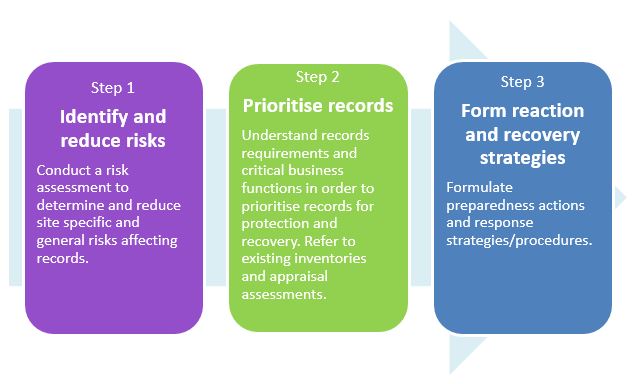About: This advice refers to physical records. The storage of digital records on network servers, in data centres, or in the cloud is NOT covered by the scope of this guidance. The protection and recovery of digital records needs be addressed within your Public Office’s business continuity plan.
2.1 Counter disaster plans
A counter disaster plan aims to minimise risk and ensure that in the event of a disaster, quick and decisive action can be taken to get salvage efforts underway, before circumstances result in further damage to records.
Objectives of a counter disaster plan are to:
- Mitigate risks affecting records
- Prioritise records for protection and salvage
- Outline what to do in different disaster situations
A counter disaster plan for physical records should complement and be integrated with business continuity plans and other emergency procedures.
It is important that the development of a counter disaster plan has executive support and approval, and is supported by a governance framework.
2.2 Establishing the planning team
Staff from a range of workgroups need to be brought together to identify specific risks, prepare the counter disaster plan, and take charge in the event of a disaster.
Ideally this team would include the,
- Senior Responsible Officer
- Records Manager, and
- whomever has responsibility for insurance coverage and liaison
as well as staff representatives covering functions, such as;
- Executive/senior management
- Building/Facilities management
- Records and information management
- Work Health and Safety
- Site security
- Strategy and governance, and
- Corporate services.
The team will need to nominate a Co-ordinator to oversee response activities and assign duties. The Co-ordinator must have appropriate delegation (i.e. senior manager / executive) to declare a disaster and to escalate issues to the CEO or beyond the organisation. A deputy Co-ordinator should also be nominated as an assurance measure.
In addition to taking charge in the event of a disaster, the team’s responsibilities are to:
- undertake a risk assessment to identify potential disaster scenarios
- develop response plans for identified scenarios
- ensure salvage priorities are known and included in the counter disaster plan, and
- regularly monitor and review counter disaster plans.
2.3 Plan coverage
A counter disaster plan needs to cover all aspects of disaster preparedness from prevention, protection and response, to recovery and rehabilitation, and consider records in all physical formats and locations, regardless of whether they are temporary or permanent records.
The plan needs to:
- document disaster preparedness, response, and recovery procedures
- complement and be integrated with business continuity plans and other emergency procedures
- be regularly revised and practiced
- include information about insurance coverage, and
- include provisions for emergency access to equipment and supplies.
The plan should be supported by:
- a clear policy statement which mandates the plan and defines responsibilities (requirement under the Standard on Records Management)
- results of a risk assessment and analysis, and
- list of priority records and retention requirements.
2.4 Key steps
Counter disaster plans can be formulated by following these key steps: Depending on your public office's circumstances you may choose to undertake these steps in a different sequence or concurrently.
Depending on your public office's circumstances you may choose to undertake these steps in a different sequence or concurrently.
2.5 Example of plan structure
A counter disaster plan may have the following structure:
- Introductory statement (including purpose, objectives and scope)
- Responsibilities and duties of key personnel
- Emergency contact tree (including disaster response team and general staff)
- Summary of threat assessment/risk analysis
- Prevention measures
- Goals and objectives for training, testing and review
- Information about insurance policies and key contacts at insurance provider
- Response procedures (including arrangement for alternative sites and communication strategies)
- Lists of contacts for additional assistance such as disaster recovery vendors and suppliers of additional resources
- Floor plan showing storage locations, disaster response supplies, and emergency exits/alarms
- Summary information about inventories of records prioritised for salvage, and retention and disposal authorities
- Guidance and procedures for records salvage and recovery
- Results of plan monitoring and testing, and
- Review/revision schedule.
Plans do not always need to be established from scratch, existing plans or templates can be used provide a base, however, they must be customised to address site specific risks identified through the risk assessment.
2.6 Collaborative efforts
Public offices may wish to pool resources with other public offices to work together on aspects of counter disaster plan development, collaborative efforts can allow for:
- identification and treatment strategies for common risks
- development of common response strategies with can be deployed regardless of location
- identification of sources of expert assistance
- sharing of resources and costs e.g. shared training or supplies, and
- establishment of a regional support network where a number of public offices could assist each other when a disaster strikes.
However, not all risks or strategies will be common, public offices also need to consider site specific or record specific risks, and be fully aware of their own capabilities and the level of outside expertise required.

